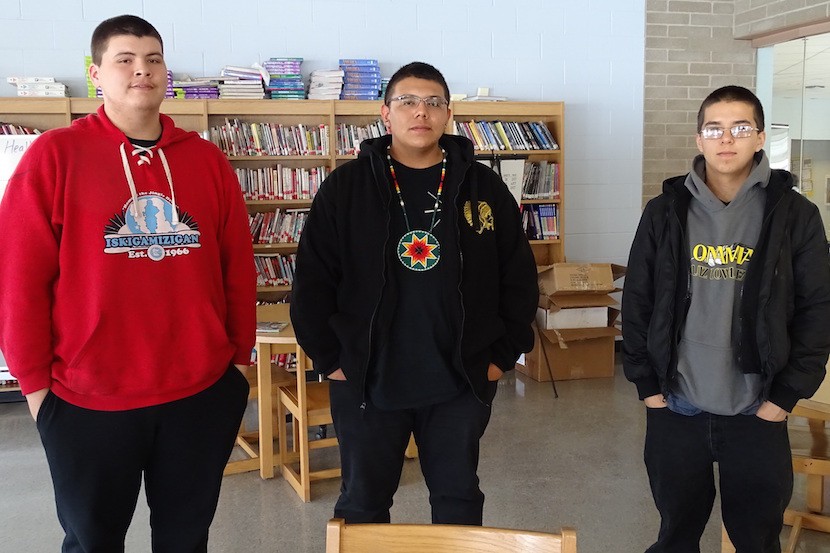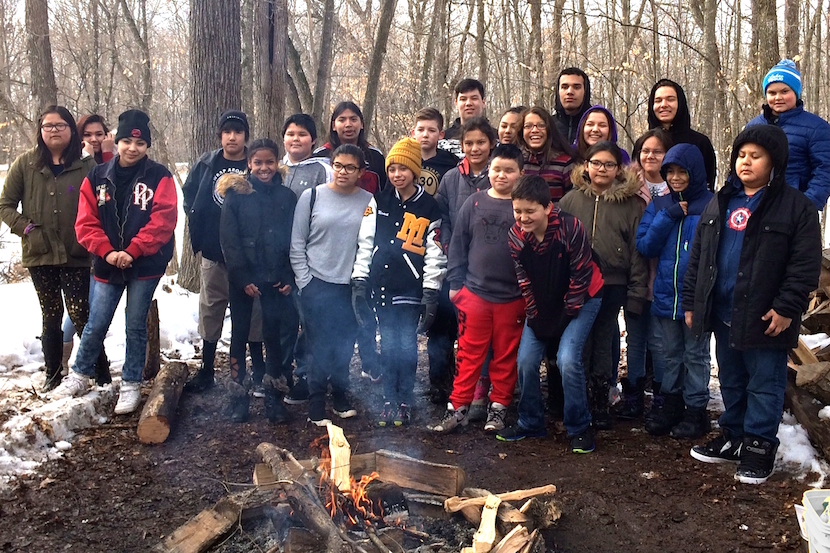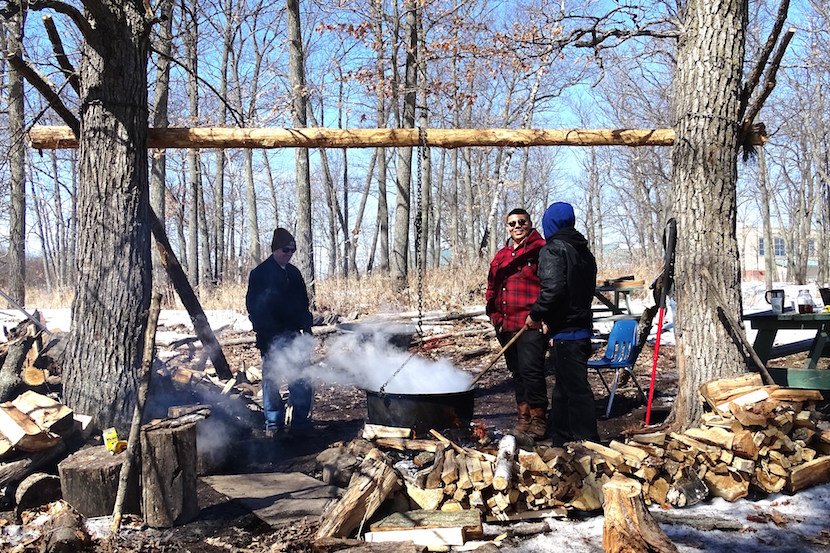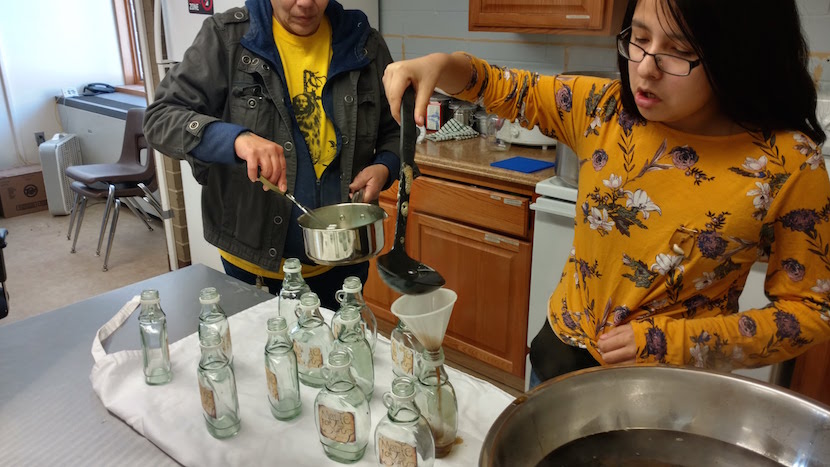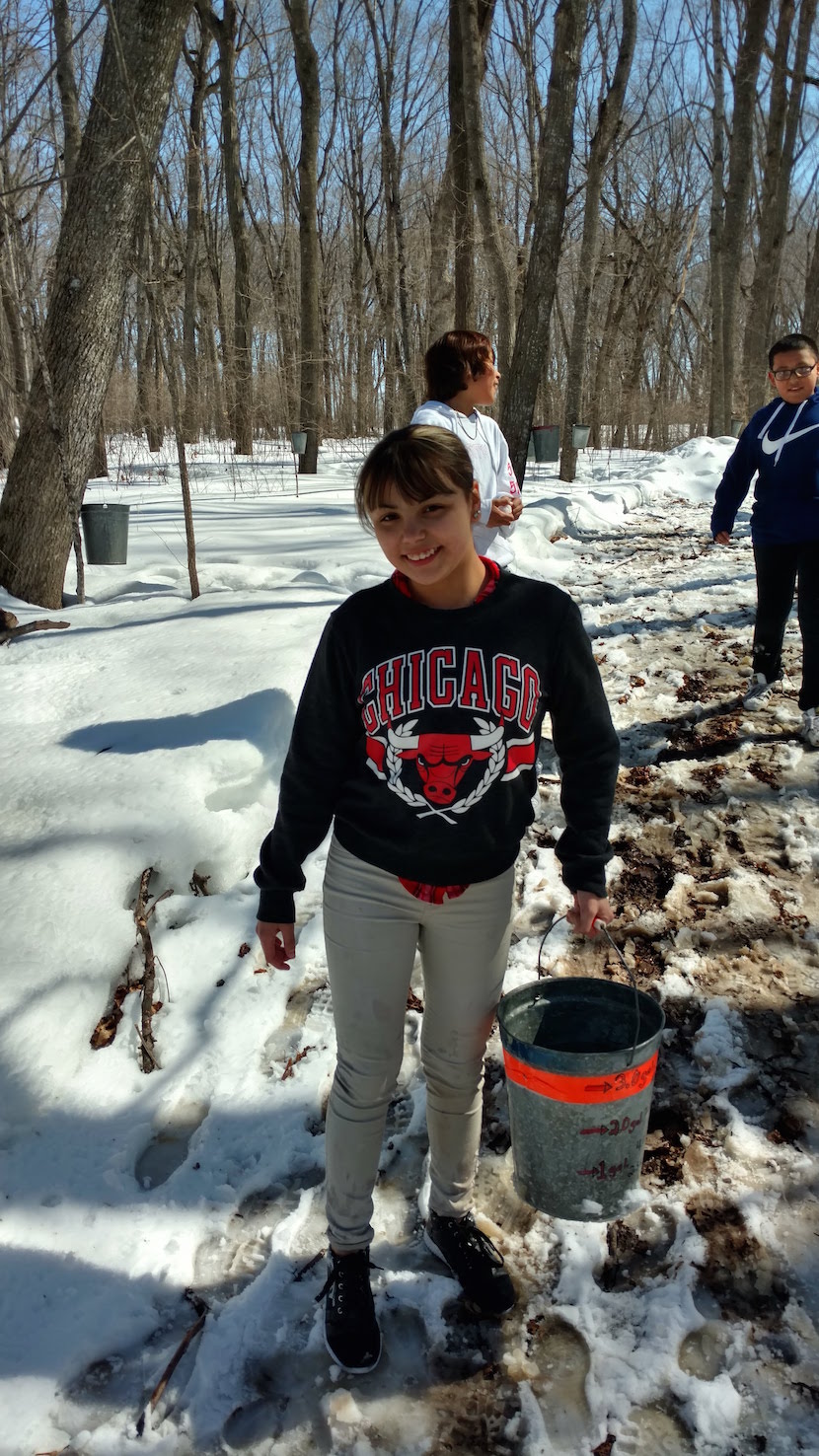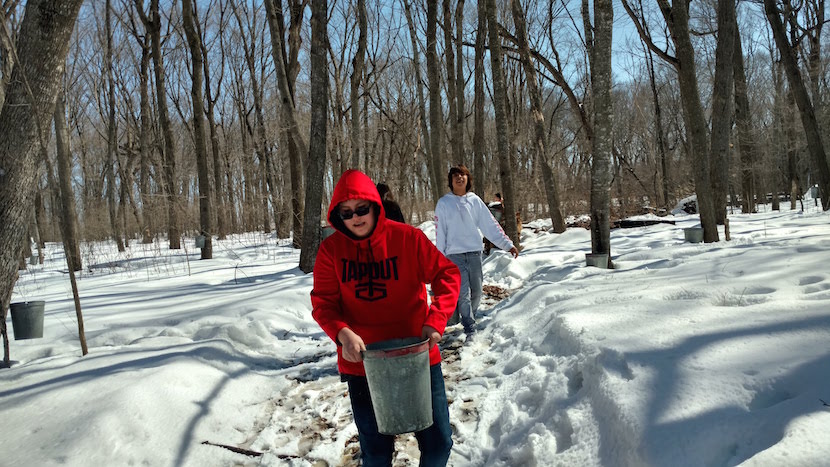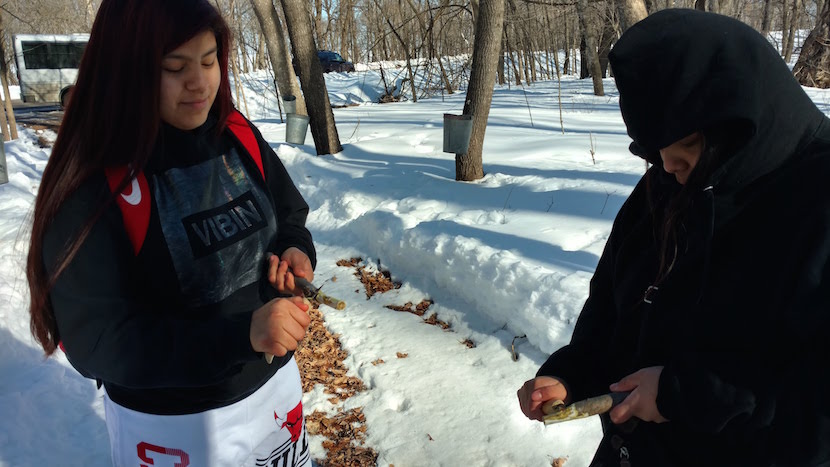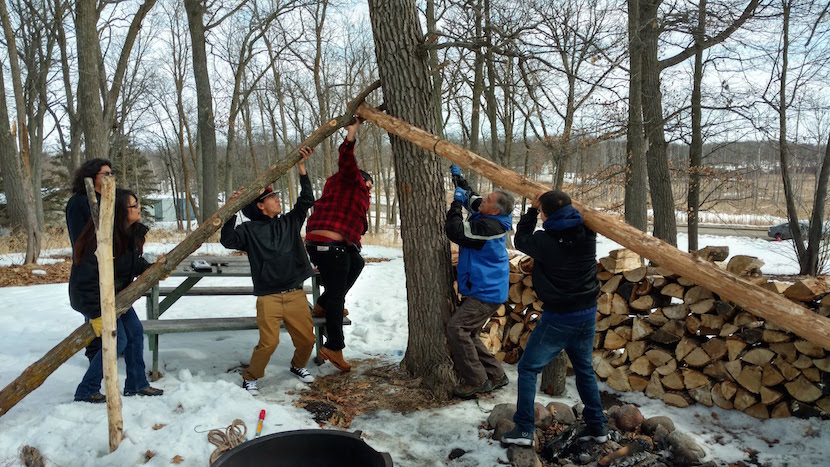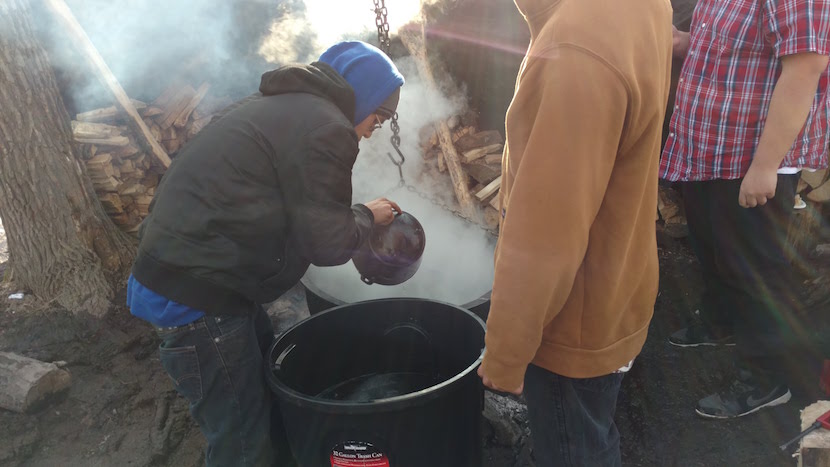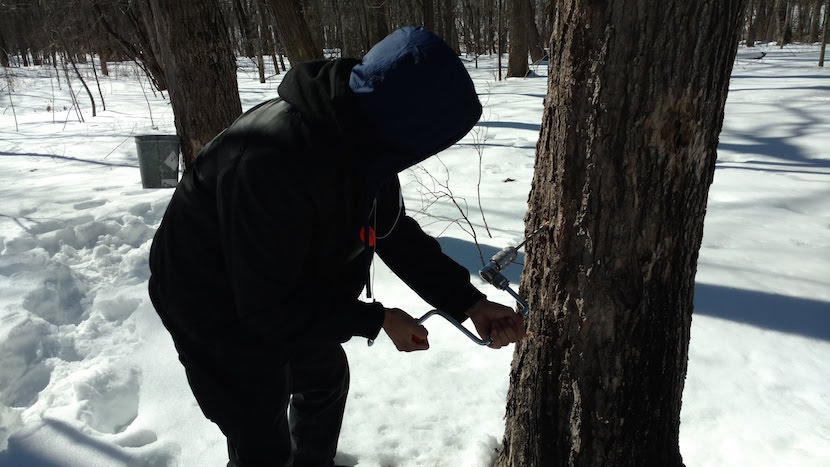Previous
2019 State of the Band Address
A Wild Ride with the GoodSky Boys
Community Efforts Delay Sandpiper Deadline
Opiate Addiction in Newborns Affecting Community
Separation of Powers Provides Checks and Balances
Youth Attend National Conference in Atlanta
Apply Now for PCs for People
Pipe and Dish is a Nay Ah Shing Tradition
Road Crews Gear Up for Winter with New Trucks
Benjamin is a Lifelong Learner – and Teacher – of Ojibwe
‘Cardio Sampler’ Gets Students’ Hearts Pumping
NON-REMOVABLE: Band Still Fighting for Reservation
Band Members Urged to Aim High
Opiate Problem Affects Everyone
Career Focused: Band Members Dedicated to Following Legal Path
Cultural Sovereignty a Major Theme at 2015 State of the Band
Legislative Counsel Stacey Thunder Unveils New Online Series
Gii Dodaiminaanig, Our Clan System
2015 State of the Band Address: Protecting the Gift
Minisinaakwaang Leadership Academy Now Offering ITV College Courses
Nay Ah Shing Staff Invited to Schoolyard Garden Conference
TERO Director Named to National Post
PCs for People Application Deadline Extended
Band Hosting Elder Abuse Awareness Conference
Commissioner Appointed to National Board
Fighting For His Culture
Hwy 169 lane closures in Vineland Feb. 9–27
Cement Mason Union Training Available
Elder's Passing Results in Controversy Over Autopsy
Rights Celebrated at Treaty Day Events
Early Education Awarded with 4-Star Parent Aware Rating
Pine Grove Proposed as NASS Satellite
Anti-Bullying Club Sends Positive Message
Fighting for our Future: Preventing and Stopping Opiate Abuse
Partners for Prevention: Helping Kids Make Healthy Choices
Band Leading Charge for New Legislation on Autopsy Objections
Chief Executive Benjamin Receives Tim Wapato Sovereign Warrior Award
Opiate Abuse Awareness Takes Spotlight
Celebrating Treaty Day 2015
Sugar Bush Season: One Sweet Tradition
Straight Talk with Joe Nayquonabe
Bella Boyd Honored at Special Olympics Minnesota Event
Mille Lacs Polar Bear Plungers Raise More Than $42,000!
Education Department Focuses on Graduation Rates
Students, Staff Celebrate Dr. Seuss’ Birthday
Low Walleye Numbers Mean Smaller Tribal Harvest
What is Self-Governance? Just Ask John
New Judge Is at Home Away From Home
24th Annual Mille Lacs Band of Ojibwe Grand Celebration
Adopt-a-Shoreline Returns: Let’s Clean Up the Lake
Making the Most of the College Experience
Nay Ah Shing Graduates Looking Forward to Future
Joe Nayquonabe Named NAFOA Executive of the Year
From Government to Casinos — Living History with Doug Sam
Band Member Following Dream to Florida
Onamia Lady Panthers Chasing Hoop Dreams
9th Annual Ojibwe Language College Quiz Bowl
Chiminising Elder Shaped by Cultural Ways
Student Achievement Celebrated at American Indian Graduation Banquet
Protect Our Lands From The Sandpiper Pipeline
Band Member Has a Thirst for Knowledge
Photos from the 2015 Memorial Day Powwow
Department of Justice Proposes Legislation to Improve Access to Voting for American Indians and Alaska Natives
Forty-One Defendants Charged With Conspiracy To Traffic Drugs To Indian Reservations
From the Brainerd Dispatch
National CPR & AED Awareness Week is June 1-7
Cultural Artist Joni Boyd Teaches Youth Traditional Ways in Summer Classes
From MPR: Minnesota tribes press concerns over pipeline plan, wild rice
Anishinaabe Immersion Camp is June 23 through 25
Band Members Producing Jingle Dress Documentary
EZ Enrollment Day at Anishinaabe College
Historic Agreement Reached to Combat Crime
State Patrol looking to diversify workforce
Transportation available to Sandpiper hearing June 5
Band Hosts Tribal Relations Conference
Band Hosts Tribal Summit On Crisis of Indian Children
Minisinaakwaang speaks out against Sandpiper
Pine Grove Satellite Project Approved
ATV classes scheduled in all three districts
Eddy’s Resort: Same Name, New Look
Grand Casino Hinckley to host National Indian Gaming Commission training
Wanted: Youth powwow dancers
From the Duluth News Tribune: Mille Lacs band vows to fight Sandpiper
County rejects Social Host Ordinance
From the Star Tribune: Pipeline protest draws marchers to St. Paul
Breaking the Silence: Confronting the Problem of Elder Abuse
From the Mille Lacs Messenger: Mille Lacs Band protests pipeline
Niigaan basketball camps are June 16-18
Hinckley prepares for a Grand Celebration
From the Mille Lacs County Times: Principal Norberg begins journey into retirement
Join the 14th Annual Walk around Mille Lacs
Mark your calendar: Inaugural Gii-Ishkonigewag Powwow is July 24-26
Nay Ah Shing fifth grade graduation
Walking with Water at Nay Ah Shing
Graduate recognition ceremony is this Wednesday
Wii Du youth learn CPR
From the Brainerd Dispatch: Anishinaabe — Healing culture, healing oneself
Hwy. 169 project on schedule
Men to gather at District I immersion grounds
Nay Ah Shing Students Go To Purdue University
Band members kick off NCAI conference in St. Paul
District II community meeting features information, inspiration
132 honored for educational achievement
Election to be Held on MCT Membership Amendment
Minisinaakwaang Says No to Sandpiper
Notice of Public Meetings on Proposed Pipeline
Office Building Grand Opening in Hinckley
Indian Education Funding Gets Boost from State Lawmakers
Lawsuit Challenges Minnesota Adoption Law
Mille Lacs culture showcased in St. Paul
Benjamin sworn in for new term
Chiminising to host basketball tourneys
Grand Casino Hinckley Hosts Training Conference
Mobile Dental Clinic
Native Pride: Bill Schaaf’s Life of Service
Open house at Hinckley Medical Office Building July 23
Klapel’s Vision for DNR Based on Anishinaabe Values
Know the Rules for Dog Ownership on Tribal Lands
Moose, HHS Take Steps to Combat Opiates
DNR Installs ‘Beaver Deceiver’ in District III
Band Joins Fish and Wildlife Service to Celebrate Refuge Centennial
From NPR: White House Hosts Tribal Youth
Register Now for the 2nd Annual Family Golf Outing
DNR: State anglers closing in on walleye quota
Nay Ah Shing Students Return from GERI Residential Camp
From the Aitkin Age: CLC hires first local Ojibwe speaker/teacher
Gii-Ishkonigewag Powwow is July 24-26 in District II
From the Aitkin Age: Remembering the Sandy Lake tragedy
MIKWENDAAGOZIWAG: They are remembered
Anishinaabeg Gather to Remember Sandy Lake Tragedy
State May Shut Down Mille Lacs Walleye Harvest
Former Speaker Was a Man of Compassion
Commissioner Sworn in for Full Term
Mille Lacs Delegation Attends White House Tribal Youth Gathering
A Concrete Plan for the Future
Technology Provides Anishinaabe College Students New Options
‘If I Can Do It, Anyone Can’
Applicants sought for Ojibwe Immersion Academy Weekend Cohort
Cultural Center Hosts Fall Programs
New Principal Stresses Need for Change
Hand Drum Class Connects Boys to Heritage
The Good Way of Life at Minobimaadiziwin
Pine County Joins CodeRED Emergency Notification Service
St. Paul Declares Indigenous Peoples Day
Pipeline Opponents Make Their Case in McGregor
A Zest for Life: The Condensed Story of Dale Greene
Drumkeepers Call for One-Year Suspension of Netting
Second Pipeline Proposed for Sandpiper Corridor
49th Annual Traditional Powwow
Band Leaders Address Opiate Addiction with Elected Officials In Effort to Find Allies and Solutions
Healthy Food, Healthy People
Another Year of Doing What They Love
New Director Helps Minisinaakwaang Kick off School Year
Family and Frybread are Key Ingredients for a Successful Business
New Director Brings Unique Perspective
Community Support Services
Response Team Works to End Truancy
Vet Clinic Coming to District I
EPA Administrator Visits Mille Lacs
Highway 169 lane closures north of Milaca begin Sept. 1
Court Rules that Sandpiper Decision Was Illegal
Minnesota Indian Housing Conference, Sept. 15, 2015, Welcome Remarks by Chief Executive Melanie Benjamin
Chief Executive Addresses Housing Conference
From the Aitkin Independent Age: A Crude Awakening
Band Hosts Nibi Miinawaa Manoomin Symposium
Harvest, Poach, Jig, Winnow: Ricing Process is Tribal Tradition
History and Culture Are Alive at Rice Lake Landing
October is the Falling Leaves Moon
Band and State Leaders Continue to Build Strong Bond
Where There’s Smoke, There’s Firefighters
Wild Rice and Habitat Restoration on Lake Ogechie
Band Member named Executive Director of Minnesota Indian Affairs Council
Ground Broken for District I Housing Development
Band Departments Provide Supplies for the New School Year
Mille Lacs County Board Votes to Terminate Law Enforcement Agreement
Catholic Charities Seeks to Build Community to Work on Key Issues
Mille Lacs Band Divests from Wells Fargo
New Resource Officer Hired for Nay Ah Shing Schools
Sheriff, Police Chief Address District I Community
Ayaabadak Ishkode
Band Members Graduate from Pre-Apprenticeship Training
Band, Pine County Sign New Law Enforcement Agreement
Chiminising Hosts Ziigwan Powwow
Good People Are All Around Us
Heroin and Opioid Forum Presents Perspectives on Epidemic
HHS Employees Attend Point of Dispensing Seminar
HHS Prepares to Re-Open Four Winds
Joanne Boyd Recognized for 10 Years of Contributions to WIC Program
Kegg’s Message Helped Preserve Reservation
Larry ‘Amik’ Smallwood: An Anishinaabe Success Story
Leaders Meet Urban Area Band Members to Provide Updates
Native Rappers Take Stage in District I
New Hinckley Community Center is Taking Shape
Public Health Sponsors Cultural Presentation
State Seeks Public Comment on Line 3
5th Annual Adopt-a-Shoreline Clean-Up Effort on Lake Mille Lacs
Band Members and Allies State Strong Opposition to Line 3
Chameleon 5K — Rainbow of Color at Rice Lake Refuge
Commissioners Discuss Concerns with District III Band Members
District II Student Headed to Indigenous Games
Emergency Response Committee Prepares for Wildfire
Gikendandaa i’iw Ojibwemowin — Learn the Ojibwe Language
Leadership Conference Addresses Culture, Communication
Memorial Weekend Features Film, Music, Art, Powwow
Nay Ah Shing Meets Goals, Raises Bar for Next Year
Our Relationship with the Environment
Red Cross Volunteers Bring Sheltering Workshop to District I
Secretary-Treasurer Attends NCAI Conference in Connecticut
State, Federal Politics Loom Large in Indian Country
State-Tribal Relations in Action: Band Public Safety Headlines Meeting with Governor
Staying Safe, Being Prepared in Summer Months
Understanding MCT- Mille Lacs Band Issues
All We Have is Each Other
Band and Pine County Continue Collaboration on Important Issues
Commissioner Stresses Natural Resources are Gifts from Manidoo
Dentists Bring Experience, Empathy to Ne-Ia-Shing Clinic
Equine-Assisted Therapy Helps Band Members Heal, Recover
Wenji-ganawendamang Gidakiiminaan
Indigenous Games Are a Family Tradition for Reuben Gibbs
Leonard Sam Ricing and Fishing
Meetings Prepare Band Members for Constitutional Convention
Minisinaakwaang Celebrates at Gii-Ishkonigewag Powwow
Minnesota Chippewa Tribe Will Hold Constitutional Convention
New District II Associate Justice is Excited by New Role
Pipeline Risks and the Next Steps
Protecting Wisdom Keepers — Elder Abuse in Tribal Communities
Road Project Raises Concerns over Artifacts, Remains
School’s IN for Summer!
State of Minnesota Working Family Tax Credit 2017 Update
Stroke Danger Threatens MN Tribes
The 1855 Reservation: M-Opinion Says Boundaries Are Intact
Treuer Addresses Cultural Continuity, Cultural Change
What Defines Me as a Mille Lacs Band Member
Wide-Ranging Discussion at First MCT Constitutional Convention Meetings
September is National Preparedness Month
Commissioner of Administration Works to Implement Chief's Vision
Mille Lacs is Second Home for New Education Commissioner
New Health and Human Services Commissioner Sets High Goals for Healthcare in Indian Country
Camp Ripley Commander Honored at Powwow
Chief Executive Melanie Benjamin's September 2017 Letter
Comment Period Open for Changes to Wild Rice Standards
A Drum Is the Heartbeat of the Mother
Band Members Invited to Smudge Capitol
Mino Bimaadiziwin Helps Band Members Overcome Barriers
Moccasin Telegraph — The Rhythm of Ricing
September Legislative Update
Traditional Images Chosen in License Plate Contest
National Preparedness Month: Make a Plan to Help Your Neighbors and Community
Airboat Training Prepares Officers for Rescue Operations
Bassmaster Angler of the Year Tournament Returns to Mille Lacs
Love Water, Not Oil — Honor the Earth Rides for Life
Mille Lacs Corporate Ventures Names Michele Palomaki CEO of Wewinabi, Inc.
Survey Says Band Members Favor New Approach to Truancy
They Are Remembered at Big Sandy Lake
DNR Commissioner Extends Ricing Hours in District I
National Preparedness Month Week 3: Practice and Build Out Your Plans
Governor Pressures County to Sign Law Enforcement Agreement with Band
Minnesotans to Gather at State Capitol to HOLD THE LINE on Enbridge Line 3
TERC Meets with Minnesota Homeland Security and Emergency Management
Chief Executive Hosts Meet-and-Greet with New Commissioners
Legislative News — License Plates, TERO, Ethics Code
Child Support Enforcement Update October/November 2017
Newest Pipeline Developments Encouraging, But Not Resolved
Line 3 Hearings This Week in East Lake, Hinckley
New Beginnings Women's Gathering
October 2017 Message from the Chief Executive
‘Percap Patrol’ Brings Anti-Drug Message to Reservation Neighborhoods
Band Members Seek Answers, Action After Surge in Overdoses
Bassmaster Brings Anglers, Crowds Back to Mille Lacs
Community Members Step Up, Come Together to Fight Addictions
District I Welcomes Teachers and Staff of Onamia Schools
Gego Awakaanaaken Giwiiji-Bimaadiziim
It's Time for Action
Minor Trust Training Scheduled for Nov. 13
Pine Grove Students Get Hands-on Lessons in Safety
Nay Ah Shing Students Learn about Safety, Fire Prevention
Band, Pine County Work Together to Hire Community Coach
Message from the Chief Executive, November 2017
‘Percap Patrol’ Leads to Discussion, Organization, Action
Band Members, Officials Present at NCAI Convention
Let Our Voices Be Heard
Micronesian Canoes Come to Mille Lacs
November 2017 State and Local News Briefs
Circle of Health Plans Weekly MNSure Enrollment Events
Mille Lacs Chapter of Natives Against Heroin Meets
November 2017 National News Briefs
Teaching People About Anishinaabe
Band Members, Employees Chosen for Leadership Training
DAR Inducted Into Minnesota Boxing Hall of Fame
HHS Meets with U of M on Drug Courts, Precision Medicine
Walk for Family Peace Brings Awareness of Domestic Violence
Wraparound Staff Attend Homelessness Conference
Zumba Dances Its Way Into District II
Grants Department Responds to Community Needs
Immersion Teacher Receives Teaching License, Second Degree
Winter Hazard Awareness Week is Nov. 6-10
Pine County, Mille Lacs Band Seek Applicants for Community Coach Position
Mille Lacs Band Designated Heart Safe Community
Onamia Teachers Learn Ojibwemowin
Pine Grove Update — Safety, Weather, New Books
Tribal Cultural Surveys in Progress on Proposed Pipeline Corridor
Grand Casinos Honor Veterans with Free Meal
Mille Lacs Band Receives Grant to Address Opioid Crisis
Department of the Interior Searches for 17,000 Native American Individuals to Claim Accounts Before November 27 Deadline
Band to Hold Law Enforcement Rally at Capitol
Letter from Feds Confirms Boundaries, Law Enforcement Powers
Mille Lacs Band of Ojibwe Files Lawsuit Against Mille Lacs County
Secretary of Interior Meets with Band, County on Law Enforcement
Band Members Rally to 'Un-Cuff Our Cops'
WEWIN Experience Inspires Youth to Take Action
Blandin Provides Lessons in Leadership and Community
Mille Lacs Band Broadband Vision, Projects Held up as Example at Statewide Conference
Annual Corporate Ventures Fall Feast
December Message from the Chief Executive
Max and His Flutes
Mediation Stalls; County Hires Attorney
Wenda-noomage-apaginigod A’aw Anishinaabe — Drug Abuse Among Anishinaabe
The Healing Power of Running
Quilting
Tribal Court Seeks Special Magistrate
Deadlines Approaching for Insurance Applications
Former Inmate Gives Back to Correctional Facility
Vet Clinic Coming to East Lake
Band Members Share Stories at Tribal Opioid Summit
Elder Refreshes Nursing Skills
Ge-Niigaanizijig Storytelling Camp
Psychologist Speaks on Race Relations, Economic Disparities
Pet Health Clinics Return to Districts I, II, and IIa
Attempted Eagle Rescue Shows Danger of Lead
Community Center is the Place to be for District I Teens
Former NHL Scout Donates to Kindergarten Class
Making Culture Cool Again
Ricing School — Learning, Fun Combine at Manoomin Harvest
Treuer Presents an Honest History of Thanksgiving
Band Members Ask Questions, Give Feedback to DNR
Ojibwe Language Becoming Priority at Onamia Schools
Pine Grove Students Study Planets, Art, Anatomy
Chippewa Tribe 2018 Election Calendar Released
LEECH LAKE BAND OF OJIBWE FILES LAWSUIT AGAINST OPIOID MANUFACTURERS
Band’s Broadband Efforts are Model at Statewide Conference
Insurance Deadline Is January 14
Message from the Chief Executive
New License Plates Available from DMV
Per Cap Patrol, Tribal Police Offer Mutual Support
Constitutional Convention Heading to Grand Portage in January
Band, Pine County Share Local Government Innovation Award
January 2018 Legislative Update
January Pine Grove Update
Mediation Continues, County Responds
County Board Approves Contracts for Legal Defense of Sheriff, Attorney
Program Fair Comes to District II
District I Health Clinic Is Taking Shape
Charlie Lippert — Engineer by Day, Language Learner by Night
DNR Program Receives Award for Fish Hatchery
Enbridge Obstacles Can’t Stop Protectors
From the Pain, to the Game
Keeping the Ojibwe Language Alive
Virgil Wind — School Board Chair Extraordinaire
Chief Executive Highlights "New Warriorism" in State of the Band Address
Executive Branch Commissioners' Reports
2018 State of the Judiciary
Police Chief Sara Rice Becomes First Tribal Chief on Minnesota POST Board
Winter Storytelling Event Focuses on Keeping Tobacco Sacred
Gaa-izhi-ina’oonwewizid A’aw Anishinaabe-abinoojiinh — What the Manidoog Gave Us as Anishinaabe to Help Our Babies
GLIFWC Officials Study Resource Management in Peru
Commissioners Attend Indigenous Governance Program
Youth Create Tribute to Mentor With Help From Native Artist, Community Members
Moccasin Telegraph — Preserving Our Language and Culture
State of the Judiciary: The ‘Ripple Effect’ of the Opioid Crisis
Band Assembly Called to Order — 2017 Legislative Highlights
February News Briefs
A New Warriorism — 2018 State of the Band Address
February Band Briefs
Power to the People — Leaders Praise Grassroots Efforts
GLIFWC Announces 2018 Summer Internships
Tribal Police Chief Earns Back-to-Back Honors
HHS Sponsors Manoomin Cookoff
East Lake Hearing Focuses on Cultural Impact of Proposed Line 3 Pipeline
Urban Youth 'Shop with a Cop'
Positive Indian Parenting Training for Trainers
Trainees Convert Centers Into Shelters
Candidates Certified for April 3 Primary Election
Igloo Project Makes Learning Fun for Wewinabi Students
Mille Lacs' Circle of Influence
New Date, Venue for Basketball Tournament
Waakobinigod A’aw Anishinaabe — That Which Pulls Anishinaabe From Their Original Teachings
Youth Powwow Returns to Chiminising March 24
BIA Forum Educates on Opioid Crisis
Polar Plunge Returns to Mille Lacs March 10
Affordable CPR/AED Class Coming to Urban Office
April 9-13 is Severe Weather Awareness Week
Pharmacist Shares the Facts on Narcan
Lady Baller — Chiminising Student Finds Success on Court
March 2018 Local News Briefs
March 2018 State and National News Briefs
DIIA Youth Bowls in State Tournament
Winter Camp Provides Hands-On Education at Rutledge
Band Member Artists Light Up the Cities
Moccasin Telegraph — Using Tobacco to Pray for Others
Four Winds Continues to Meet Band Member Needs
Know Your Government — Health and Human Services
Absentee Ballots Available for April 3 Primary
Biologists Give Update on Status of Ogaa
Treaty Rights Day Celebrates Heritage
Rachel Dorion — Harvesting Health
The Welcoming Face of Chiminising
Make Your Voice Heard: Vote!
Aadizookewin! Winter Storytellers Take Center Stage at Grand Makwa
April 3 Primary Will Narrow Field for Secretary-Treasurer, District Reps
April 2018 Message from the Chief Executive
April 2018 News Briefs
Band Seeks Self-Governance Growth Through Native Farm Bill Efforts
3rd Annual Ziigwan Youth Powwow
Native Governance Center Moderates Candidate Forums
Frances Davis — Living Through Changes in District I
Moccasin Telegraph — Springtime Sugarbushing
Band Members Elect New Secretary-Treasurer, Representative Candidates
District III Athletes Advance to State
Mille Lacs Band Announces Primary Election Results
2018 Spring Cleanup Is Coming!
Tony Buckanaga — Iron Chef Minisinaakwang
Chief Executive Marks Anniversary of Self-Governance with Senate Testimony
Ziinzibaakwadwaaboo Harvest Shows Reality of Climate Change
Prepared for Emergency
Band Members Encouraged to Apply to First Ever Tribal Youth Gathering
Bemidji Students Honored for Audio-Visual Production Work
Mille Lacs Indian Museum May Events and Classes
Beloved Wewinabi Gramma Retires
May 2018 News Briefs
District I Cleanup Rescheduled
Miigwanens Geyaabi Eni-dibaajinjigaazod — The Story of Miigwanens Continues
Moccasin Telegraph — Growing Up in Nature
50+ Program Provides Job Opportunities
The Generous Life of Beatrice Taylor
Diving into Mille Lacs Lake Biology
Language Warrior's Lifelong Love Affair with Ojibwemowin
Sugarbush — The Sweetest Tradition
Water is Who We Are — Protect Us
Minor Trust Training Rescheduled for May 16
House Members File Protest Against Rep. Sondra Erickson
Band Seeks Dismissal of Counterclaim
Band to Receive 5,000 Drug Disposal Kits to Safely Dispose of Prescriptions
Chief Executive Melanie Benjamin Accepts Orville Freeman Award
Big Weekend Ahead at Mille Lacs Indian Museum
Self-Governance Conference Recognizes Band's Historic Contributions
NAS takes 1st, 2nd at Annual Quiz Bowl
Students Learn Money Management from Experts at Minor Trust Training Seminar
May 2018 News Briefs
Weweni Inaabaji' Aw Asemaa League
All-Native Tourney Brings High-Energy Hoops to Mille Lacs
Fishery Committee Discusses Relationship with Tribes
Governor Vetoes Rice Bill
Lady Luck Estates Project Wins Award
HHS Department, U of M Seek to Reduce Disparities in Tobacco-Related Illness
June 2018 Message from the Chief Executive
Will the Real Wild Wild Rice Please Stand Up?
A Beautiful Day for a Powwow
'Gigsy' Brings Digital Media Training to Nay Ah Shing
Band Members Honored at Graduation Event
Elder Financial Exploitation on the Rise
The Family Violence Prevention Program Is Here to Help
Band Members Create Welcoming Environment at Four Winds
Moccasin Telegraph — The Center of the Moon
Namebinikaa! Nay Ah Shing Students Learn Spearing Tradition
Baabiitaw's Bush Foundation Fellowship: Year One
Gikendandaa i'iw Ojibwemowin — Learn the Ojibwe Language
Election Day is June 12
MILLE LACS BAND ANNOUNCES GENERAL ELECTION RESULTS
iQuits Project Presents Final Report
Band Supports Fond du Lac in Opposing PolyMet Land Swap
Heavy Haul of Trash at Adopt-a-Shoreline
Pomp and Pride at NAS Graduation
Hundreds of Pounds of Electronic Waste Recycled Through DNR Program
Community Activism Brings Awareness and Response to Foster Care Crisis
Wewinabi Students Receive Head Start Diplomas
State and Local News Briefs
Anishinaabe Values Motorcycle Ride Gears Up July 28
Grassroots Group Hosts Picnic
Keeping Tobacco Sacred is Theme of Digital Storytelling Interviews
Mark your calendar: Minnesota primaries are August 14!
Moccasin Telegraph — Summer Gathering
Outgoing Assembly Marks Accomplishments from Last Year
Anderson Shares Recipes for Success with Band Youth
July 2018 Message from the Chief Executive
Active in the Language
Former Tribal Judge Richard Osburn Running for Mille Lacs County Attorney
Opioid/Heroin Awareness Community Outreach
Vets Remember the Fallen at Normandy
ALICE Prepares Schools for Emergency
End-of-School-Year Picnic Brings Urban Members Together
Gikendandaa I’iw Ojibwemowin— Learn the Ojibwe Language
GLIFWC Healing Circle Run
National Veterans Exhibit Comes to Mille Lacs Indian Museum
Painting Unveiled Featuring Mille Lacs Band Marine Veteran
Mille Lacs Band Swears In New Band Assembly Members
Teen Pregnancy Program Completes Live It! Curriculum Implementation
Nay Ah Shing Summer School Has Something for Everyone
Baby Moccasin Class for Young Mothers
ClearWay Tribal Tobacco Grant Ends
BIA Agent Discusses Opioid Epidemic
State Approves Line 3; Opponents Regroup and Plan for the Next Phase
August Events at Mille Lacs Indian Museum
August News Briefs
First Homes Finished at Lady Luck Estates
August 2018 Message from the Chief Executive
Native Votes Needed in Crucial Primary
New Secretary-Treasurer Sets Agenda for Band Assembly
Band Participates in Healing Circle Run
Moccasin Telegraph — Fall Ricing
Native Americans Are Important Partners in Prevention
Cheyanne Peet — A Warrior Fighting an Invisible Enemy
Grassroots Groups Are Changing Minds and Changing Lives
Chief Executive Encourages Band Members to Vote August 14
Band Conducts First Telemetry Study of Mille Lacs Walleye
Mille Lacs Band endorses Keith Ellison for Attorney General
Brawn, Brains, Beauty, and Determination
Minzel Brings Her Message to District I Community Picnic
Osburn's First Priority: Fix the Band/County Relationship
Peggy Flanagan Hopes to Make History as Lieutenant Governor
Voting in Minnesota: Frequently Asked Questions
What's on My Primary Election Ballot?
Band Hosts Weekend Woodland Conference August 25 and 26
Mille Lacs Soil and Water Conservation District Board Announces Vacancy
New CEO visits Indian Museum
Child Seats, CPR/AED, First Aid, Smoke Alarms Available
Youth Firearms Safety Class
Coming Home/Facing Re-Entry Two-Day Workshop
Moccasin Telegraph — Sharing Traditions with Children and Grandchildren
Attention Turns to General Election
Band Partners with Neighbors, Law Enforcement at National Night Out
GLIFWC Holds Annual Mikwendaagoziwag Ceremony
September 2018 Message from the Chief Executive
Branches Meet in Spirit of Collaboration
DNR Fisheries Biologist Provides Update on Harvest, Telemetry Study, Hatchery
Get to Know Your Legislative Office Staff Members
September 2018 News Briefs
Stories from the 2018 WEWIN Conference
Youth Gathering Inspires Future Leaders
Early Education Department Prepares for School Year
It's a Public Affair
Youth Learn Leadership at Day Camp
Motorcyle Ride Brings Awareness of Anishinaabe Values
Nay Ah Shing's Gifted and Talented Program Brings Students to Purdue
Aquaculture Biologist Brings New Skills to Mille Lacs DNR
Ethnobotanist Shares Knowledge of Wild Food and Medicine
Growing Business Puts Family First
Police Seek Information after Tragic Death
Sheriff Releases Photo of Vehicle of Interest
Minor Trust Training Scheduled for October 17
Band, County Approve Law Enforcement Agreement
District II Receives Updates on Education, Circle of Health
Early Voting Underway; Plan to Vote November 6 or Sooner!
District III Residents Discuss Opioids, Education, Smudge Walk
Get to Know Your Legislative Staff
Pine Grove Plans for Year-Round School
Legislative Branch Plans Revisor's Office
Federal Judge Dismisses Mille Lacs County's Counterclaim
Family Hopes Benji's Death Leads to Justice, Healing, Unity
2018 Message from the Chief Executive
Community Members Come Together for Smudge Walk Following Homicide
Meshakwad Center Makes Fitness Fun
Adrienne Benjamin Selected to NCAIED 40 Under 40
Abinoojiiyag Curriculum Picks up STEAM
Band, GLIFWC Biologists Meet with State Advisory Committee
Band Hosts Self-Governance Conference in St. Paul
Camp Brings Spotlight to Homelessness
Family Atmosphere Promotes Learning at Minisinaakwaang
Immersion Program Builds on First Year's Success
Moccasin Telegraph — Respecting the Creator's Creation
Nurturing Nature — Curt Kalk Shares Cultural Knowledge
Pine Grove Students Go to Safety School
Gigitigemin Anishinaabewiyang
HHS Building, Community Center on Schedule in District I
Health and Human Services Hosts Annual District Health Fairs
Radinovich Hopes to Win Nolan's Seat
Sober Squad Brings Message of Healing, Hope, and Sobriety to Brainerd
Tim Walz and Peggy Flanagan: Your Team for Indian Country
St. John Reflects on First Four Months
Annual Walk to End Domestic Violence
Band Assembly Meets in Urban Area
Band Reaches Out to Mille Lacs Friends
DNR Involves Nay Ah Shing Students in Fishery Research
Early Education Students Crunch Their Way to Healthier Eating
Emy Minzel Seeks to Oust Erickson
Moccasin Telegraph — As Long As We Hear Those Drums
November 6 Is an Important Day Locally, Regionally, Nationally
November 2018 Message from the Chief Executive
November 2018 News Briefs
Ricing Is Always Worthwhile for Alicia
Secretary-Treasurer Reports on First 100 Days in Office
Democratic Candidates Rally on the Reservation
Steve Premo Becomes a Full-Time Artist
Band Member Wordsmith Gives Reading in Minneapolis
Historic Election for Native Americans
Native Thrive Looks to Empower Youth Through Sports
Urban Area Pays Tribute to Herb Sam
Benjamin Named to List of Influential Young Native Americans
Freddy's Passion for Makazinataagewin Spans Generations
Wiidanokiindiwag Youth Program Helps Out at Homeless Camp
DNR Hosts Presentation on the Real History of Thanksgiving
Minnesota Indian Education Conference Comes to Hinckley
Artwork Unveiled at Four Winds
NAS Student Project Earns Thumbs Up from Chief Executive
Chief Executive Appointed to Walz- Flanagan Transition Team
Government Center Name Changed to Honor Chief Executive Marge Anderson
Government Officials Welcome Students
December 2018 Message from the Chief Executive
Moccasin Telegraph — Coming Home
Vet Clinic Makes District I Pets Happy and Healthy
December News Briefs
Circle of Health Deadlines
GRA Director Provides 'Health Check' to Band Assembly
Who's Dallas? A Who, That's Who!
Sober Squad Members Gather for Training in District I
Band Members and Employees Attend Adverse Childhood Experiences Training
Urban Members Celebrate at Holiday Party
Generations Basketball Camp Brings Healthy Fun to District I
Thomas X Entertains, Enlightens, Inspires in District I
Upward Bound Helps Students Thrive in College and Beyond
A Christmas Wish and a Letter from Heaven
Using Art to Celebrate Diversity
Welcome Babies!
A Time Gone By
Band Members Attend Chamber Dinner
Community Development Hosts Public Meetings in January
Director of Department of Athletic Regulation Provides Update to Assembly
Anishinaabe Ice Fishing!
Counselor Knows Both Sides of Treatment Experience
Curtain Rises on Meshakwad Center
Judges Seek Input on Court System
Moccasin Telegraph — Winter Legends Start with Snowfall
January 2019 News Briefs
Band Hosts Multijurisdictional Training
Band, Pine County, East Central Public Schools Recognized for Cooperation
Lifelong Learner Is Ready to Help Others
Personal and Professional Growth Go Hand-in-Hand
'New Warriors,' Tribal Government Partner for Progress in Fight Against Opioids
Delegates Attend Constitutional Convention
District I Members Learn about Medication-Assisted Recovery, WEWIN at Community Meeting
February 2019 Moccasin Telegraph
February 2019 News Briefs
Long Road Back to School
2019 State of the Judicial Branch
2019 State of the Legislative Branch
Kayana Bearheart Joins the Guard
Special Election in District III February 5
'It Takes a Community to Heal a Community'
Artistic Curation of Cultural Traditions
Filmmaker, Hip Hop Artist Thomas X Coming to Hinckley
Summer Language Immersion Academy Applications Open
Winter Stories and Special Feast Fill Up Guests at Museum
Youth Embrace Biboon at Mille Lacs Indian Museum
DNR Announces Youth Color Drawing Contest
Neighbors Help Neighbors During Power Outage
Brandon Works for Success — On and Off the Court
Minnesota Chippewa Tribe Releases Wild Rice Report
Band Members Give Powerful Testimony At Opioid Hearing
Band Youth Spar with the Pros at Meshakwad
Department of Athletic Regulation brings world championship to casino
Moccasin Telegraph — Traditional Ojibwe Crafts
Get Ready for 2019 Tribal Harvest on Mille Lacs
Rarick Victory Means Another Special Election
Sovereignty Day Offers Hope for Better Future
Dad Doubles as Basketball Coach
What is Circle of Health?
March 2019 Message from the Chief Executive
Small Acts, Big Impacts
Verdict Came as a Surprise — To Some, that is
Housing Board Meets Members Where they Live
A Place to Call Your Own
Robin Eagle — The Friendly Face of Nay Ah Shing
Hot Cotton and Hissing Irons —Remembering Noni
Band Officials Attend MAST Impact Week
Office of Solicitor General Receives Patriot Award
Onamia Hosts Annual Concurrence Hearing
Chief Executive Announces Warriorism Grants
Prairie Island Prepares
Stronghearts Native Helpline Expands Hours
Band celebrates 20th Anniversary of treaty rights victory!
DNR Treaty Rights Cell Phone Photo Contest Winners!
Legislative Branch considers update to Revenue Allocation Plan
What is Purchased and Referred Care?
Mille Lacs Band Flag Flies at Family Justice Centers
Moccasin Telegraph — The Migration Story
April 2019 Message from the Chief Executive
Crafting Series Concludes with Celebration
New HHS Commissioner is ready to serve
One Year Out, Census Participation Encouraged
Sharing Culture Through Arts and Education
Zaagibagaang Uses Facebook, Web to Educate Tribal Members on MCT Constitution
Misi-Zaaga'iganing Basketball Tourney Promotes Year-Round Fitness
Natalie Weyaus — Working Through the Changes
Ziibaaska'Iganagooday Jingle Dress Exhibit opens
The Transformative Power of Anishinaabemowin
April 8-12 is Severe Weather Awareness Week
I Want to Be Like Rick — The Importance of Role Models
'Big Rig Vinny' — A Drive for Change
District I Rep Shares Band Assembly Update
Get Ready for Spring Cleanup!
Governor Walz Signs Historic Executive Order to Expand Tribal-State Relations
District IIa Learns about Medical Research
Lt. Gov. joins Tribal Collaborative Meeting
Chiminising Youth Bowlers Compete at Districts
You're Invited to the Minnesota Senior Games!
Education Commissioner Ratified
A Sisterhood of Lifelong Learners
Band Assembly Seeks Input on Proposed Amendments to Statutes
Decolonize Your Diet with Indigenous Foods
May 2019 Message from the Chief Executive
EIGHT CHARGED IN DRUG TRAFFICKING CONSPIRACY
Understand the Band's Lawsuit
Friends gather for Sober Night Memoriam
Supreme Court Decision Cements Treaty rights
Constitutional Convention Delegates Continue Discussion, Seek Input From Band Members
Time to talk — Equity Event Addresses Educational Disparities
New Solicitor Sworn In
A Healthy Adventure
Minisinaakwaang Celebrates Molly's Graduation
Moccasin Telegraph: Summer Traditions
A Healing Group for Chiminising
Bailey and Taylor Woommavovah: Twin Stars on St. Cloud Tech Softball Team
Community Members Work to Promote Mental Health, prevent suicide
Ethnobotanist Offers Services to Band Members
FOX 9 Series features Mille Lacs Band Members
Jingle Dress Centennial Celebrated at Indian Museum
June 2019 - Message from the Chief Executive
Music Festival
Nay Ah Shing Teams Shine at Quiz Bowl
Soldiers benefit from Cell Phone recycling
Working Together To Protect Our Waters
Track Star Runs in State Tournament
Smudge Walks Bring Neighbors Together in DIII
Grants Awarded to New Warriors
Health Advisory: Spike in Drug Overdoses
Ziibaaska'iganagooday Heard 'Round the World
Gii-Ishkonigewag Powwow Royalty Contest
She Is Not Invisible — Raising Awareness of Missing and Murdered Women
Pine County Campus Recognizes Anishinaabe Heritage
Tribal Consultation Agreement Signed
Wisdom Steps Conference Promotes Elder Health
Brownfields Program Receives Input from EPA
Supportive Housing Planned for District I
'We're the First Farmers of This Land'
Progress, Not Perfection
End-of-School-Year Picnic Celebrates Community, Achievements
Moccasin Telegraph — Old-Style Cooking
Adopt-a-Shoreline Takes Out the Trash
No Summer Vacation for Basketball Brothers
Anishinaabe Values Ride for Recovery is July 6
Graduates to Be Celebrated at Luncheon
Healing Circle Run is July 13-20
Mending Broken Hearts Training
Urban Site Manager Finds Her Passion
Wewinabi Inc. Offers Jobs, Special Discounts to Band Members
Possible World Record Muskie Boated and Released by Mille Lacs Band DNR
Mille Lacs Children Participate in Nature Walk, Cucumber Crunch
2019 Creative Native Call for Art
Why Housing Matters
Delegates Receive Training in MCT Constitution
Meet Your District III Constitutional Convention Delegates
Commissioners Receive Census Update
A Fish Story with Endless Possibilities
Cultural Role Models
Family Spirit Home Visits Help Growing Families
Siblings Launch Podcast
Pine County Wins Juvenile Justice Award
Ninham Named Interim Nay Ah Shing Principal
Breaking the Cycle
Making His Mark in Music, TV
August 2019 Message from the Chief Executive
A Royal Year for Powwow Princess
Applicants Wanted for Crime Victim Needs Assessment Community Advisory Group
Immersion Academy Weekend Cohort Seeks Applicants
MENTOR ARTIST FELLOWSHIP OPEN CALL
Urban Office, District I Host National Night Out
District III Members Receive Updates
Hands-Free Cellphone Law Is Now in Effect
DNR, Government Affairs Host Telemetry Open House
Mille Lacs Corporate Ventures Associates 'Unleash the Power Within'
Mille Lacs Band Women Bring Energy to WEWIN
Dispatches from the Mille Lacs Powwow
Advocates Available for Elders, Families
Corporate Ventures Interns Complete Summer Experience
Constitutional Convention Survey Results
Representative Blake Attends Housing Conference
Commissioner Brings Commitment to Culture
Oppression — A Band Elder Reflects
Heart-Mending, Life-Changing
Partnership Seeks Better Cancer Outcomes for American Indians through Research
September 2019 Legislative Briefs
September 2019 Message from the Chief Executive
Project Mezinichigejig Helps Band Youth Find Their Voice, Discover Talents
Jingle Dress Symposium — Inspired by History
Lakeside Stories — Original Theater by Local Youth
Miigwech, Monica
Mille Lacs Band members invited to Changemaker Retreat November 19-21
Ikwe Oganawendaan Nibi Miinawaa Manoomin
District I Meeting — Niigaan, Wiidoo, Wraparound Updates
Attorney Bound for Afghanistan with Reserves
Former Director Returns to Public Health
GLIFWC Offers HACCP Certification Course
More Than Just Fair-Weather Friends
TERO Director Wants to Help Band Members Succeed
Convention Delegates Address District III
Spirit Foods — Ethnobotanist Brings Band Members Back to Their Roots
Commissioner to Serve on MMIW Task Force
Meet Your District IIa Convention Delegates
Revisor's Office Takes Shape with New Addition
Understanding ACEs Helps Band Members Break the Cycle of Trauma
October 2019 Message from the Chief
'We Are Water' Exhibit Takes a Look at Minnesota's Way of Life
Legislative Hosts 3-Branch Meeting
Band Employees Attend NAFOA Conference
Vaping Illness Outbreak Update
Indigenous Peoples' Day Event Draws Large Crowd
Mille Lacs Recognized as Official Scenic Byway
Can You Dig It? Earthworks Does!
There Is No Honor in Racism
November 2019 Message from the Chief Executive
Remembering Leonard Sam
Niiyawen'enh
2020 Census Update — Be Sure to Check the Box
It Is Always a Choice
Self-care and Leadership Discussed at Women's Gathering
Mending Broken Hearts — The Trauma Stops Here
Hip-Hop and Politics
The 'Other' Legislature — Band Assembly Members, Staff Visit Capitol
A Family of Warriors
Healthy Pets, Healthy Community
Heroin Dealer Sentenced in Federal Court
Shaping the Future with a Complete Count
Actors Needed for Ojibwe Language-Learning Videos
Adopt-a-School Program Helps Students Succeed
Honored for Giving Back
ICWA — It Takes A Community to Keep Kids at Home
December 2019 Message from the Chief Executive
Johnny's Pheasant — A New Book by Band Member Cheryl Minnema
Making Her Own Way at B.A.T. Entertainment
Drum and Dance — Healthy Fun in District II
Band Assembly Proposes Open Meetings and Data Privacy Statute
Book Project Features Stories by Elders
New Attorney Brings Indian Country Experience
Artist Shares Jingle Dress Tradition at Central Lakes College
'I'm Thrilled to Be Back' — Mel Towle Sworn In As Commissioner of Finance
Community Learns Harmful Effects of Vaping
Would-Be Actors 'Break a Leg' at Rosetta Stone Auditions
Telemetry Research Includes Odoonibinh
Ojibwe Language Books, Rosetta Stone Will Contribute to Healthy Communities
Minnesota Chippewa Tribe 2020 Election Calendar
EPA Helps with Fuel Tank Clean-up in District I
The Constitution and Tribal Sovereignty — Let's Learn Together
Lost Boys and Broken Toys
Kids Count! Shape Children's Future in Census
Our Mississippi, Our Future
Coach Mom
Forever In Grey
Chief Attends White House Signing of MMIW Executive Order
January 2020 Message from the Chief Executive
Walking on Water
Model Student, Athlete, Leader
Why Write Stories?
Election Board Positions Open in All Districts, Urban Area
Filing Period Begins January 14 for Minnesota Chippewa Tribe Elections
Be Good Ancestors, Fight the Battles You Must, says Chief Executive Benjamin
Scholarships Available for Full-time Ojibwe Language Students
2020 State of the Judical Branch
Nayquonabe Named Assistant Commissioner of Administration
New Face in Urban Office — Billie Berry
Work, Sacrifice, and Gratitude — 2020 State of the Legislative Branch
Commissioner of Natural Resources Is New State DNR Liaison
Drum and Dance — Unity in Our Community
Questions and Answers about Census 2020
Ribbon Skirt Class
GLIFWC Announces Summer Internships
Band Member Wins Children's Literature Award
Absentee Ballots Now Available for March 31 Primary Election
MCT Student Handbook
Band Member Update on COVID-19
Early Education Program Closed Until Further Notice
State of Emergency Declared; Emergency Response Plan Activated
GRAND CASINO ANNOUNCES TEMPORARY CLOSURE OF MILLE LACS AND HINCKLEY CASINOS
Tribal Government Reduces Staffing Levels
Tribal Government Reduces Staff to Protect Communities
HUD Provides List of Low-Cost Devices, Learning Content, and Free or Low-Cost Internet Service
COVID-19 Information
StrongHearts Native Helpline Continues to Offer Services
Mille Lacs Band Issues Stay At Home Order
Stay at Home order issued by Chief Executive Melanie Benjamin
April 2020 Message from the Chief Executive
Health Officials Confirm First Case of Coronavirus COVID-19 in Mille Lacs County
Walleye Harvesters on Mille Lacs Encouraged to Use Landing Declaration Form
COVID-19 Cases Confirmed in Region
Little Spirits and Pandemic
May 2020 Message from the Chief Executive
Response Committee Remains Vigilant in COVID-19 Prevention
A Strong and Resilient People
DNR assists with bog cleanup in Onamia
Grand Casinos Issue Safety Plan
Health Services Remain Available
Health and Human Services Department readies for move
Schools Make Adjustments, Plans for Summer and Fall
Telehealth Takes Off During Pandemic
STAY-HOME ORDER STILL IN PLACE
Commissioner's Order Requires Masks on Band Property
COVID-19 Reaches Band Communities
BAND, MAYO CLINIC PARTNER FOR TESTS
Band-wide COVID-19 testing begins June 2
GRAND CASINO ANNOUNCES REOPENING DATE
Primary Election is June 9 — Absentee Voting Encouraged
Band Members Protect Native Buildings in Minneapolis
COVID-19 Testing Kicks Off in District II
Aanjibimaadizing offers education and training opportunities
A Statement from Mille Lacs Corporate Ventures on the murder of George Floyd
2020 Tribal Election Guide
Primary Narrows Field for Chief Executive, District I Representative
Bradley Harrington Files for Mille Lacs County Commissioner
IMAGEN PROGRAM SEEKS TO EMPOWER BAND MEMBER GIRLS
Weekly news summary, June 8-12
Mental Health Program Offers Help in Times of Crisis
Ge-niigaanizijig director stresses mentorship, transitions
From high school dropout to master's degree
IllumiNative, Sundance Institute and The Black List Collaborate For Inaugural Indigenous Screenwriting List
Absentee Voting Encouraged for General Election
Band Assembly establishes protocol for drafting legislation
Band Was Prepared for Pandemic — Thanks to the TERC
CARES funds finally reach tribes
Help slow the spread of COVID-19
Police chief participated in working group on use of deadly force
Weekly News Summary, June 20-26
Atlantic Coast, Dakota Access, Keystone XL: Three major defeats for Big Oil. Is Line 3 next?
U.S. Senator Tina Smith Says Congress Must Address the Crisis of COVID-19 in Tribal Communities
NCAI: Historic win for Muscogee Nation
Band member cares for community through work
Minnesota Indian Affairs Council Seeks Immediate Action from University of Minnesota
Representative seeks volunteers for child protection subcommittee
Mille Lacs Corporate Ventures Announces Promotions
Charter Associates (and Sisters) Bid a Grand Farewell
DNR to Host Manoomin Meeting August 5
Scholarship Program Now Processing Funding for Fall 2020
DII, DIII Convenience Stores Reopen in August
Reflections from a 2020 High School Graduate
Mille Lacs Corporate Ventures Obtains 8(a) Certification
Band Assembly reviews proposed legislation to create Leasing of Trust Lands Code
How to vote absentee in state and tribal elections
Smith faces challengers in August 11 state primary
Band Assembly Reviews Proposed Amendments to Titles 12 and 21
Manoomin Meeting Draws Big Crowd
Secretary/Treasurer Seeks Candidates for GRA Board
Band Assembly Weekly Update: Band Assembly Weekly Update, August 3-7, 2020
Early Ed Releases Preparedness Plan in Preparation for Phase 1
SCOTUS Affirms Reservation — Upholds Jurisdiction to Protect Native Women
Report Informs Band Members of Government Action During Pandemic
Wind, Benjamin prevail in general election
Wind, Clitso-Garcia running for Onamia School Board
Aanjibimaadizing is local administrator of COVID-19 Housing Assistance Program
Mask Order Extended Through November 30
Monolingual Ojibwemowin Books Are Now Available
Band Member's Artwork Featured in Minneapolis
Commissioner's Mask Order Extended
'HAWK' CROSSWALK WILL ENHANCE SAFETY IN DISTRICT I
September 2020 Message from the Chief Executive
Census Deadline Is Coming Soon
Wraparound Moves to Aanjibimaadizing
A Busy Month for Band Assembly
Casinos Announce New Positions for Band Members
District III Holds Community Meeting at Casino
DMV Closed September 8-11
School Year Begins with Major Changes
Frequently Asked Deer Harvest Questions
Swearing-In Ceremony for Chief Executive, District Representative Is September 8
Chief Executive, District I Representative Sworn In
Band Assembly Establishes Agenda and Live-Streaming Procedures
Virgil Wind Takes Office as District I Representative
Stronghearts Scales to Respond to Crisis within a Crisis
Virgil Wind, Becky Clitso-Garcia Running for Onamia School Board
Community Meeting Provides Update on Urban Housing Project
Manoomin Presentation September 26-27
Early Ed Seeks Members of Policy Council
Band Provides Antibody Tests
Band Receives Entrepreneurship Grant
Band Assembly Weekly Update for September 21-25, 2020
Becky Clitso-Garcia — Asking for Your Support on November 3
Secretary-Treasurer's Midterm Update
Elders Can Experience Domestic Violence
October 2020 Message from the Chief Executive
Tragedy Remembered in Online Ceremony
Band Assembly Weekly Update: Week of September 28-October 2, 2020
Meet the New Providers at Ne-Ia-Shing Clinics
Students Crunch Together for Farm-to-School
Successful Partnership Leads to Successful Students
Weekly News Summary, October 4-10
Taking a Stand by Taking a Knee
Investments
Band Assembly Weekly Update, October 5-9
The Unsung Hero of the Legislative Branch
Election Guide Sent to Band Members
Nazhike — Tough Decisions Shinaabs Make
New Ordinance Modifies Child Support Code
Weekly News Summary for October 11-16
Comment period open for draft Revisor's Office statute
Separation of Powers Helps Ensure the Survival of Our Sovereign Nation
Aanjibimaadizing Moves to Former Clinic Building
Band Assembly Weekly Update, October 12-16
The Real Meaning of Community Service
Weekly News Summary for October 18-24
Detailed Gaming Regulation Revision Project
'You're Coming with Me!' — A Love Story for the Ages
Band Member Voices — Zooming Towards Recovery
Band Assembly Weekly Update, October 19-23
DNR wants your opinion on management plan
Interim Early Ed Director is Head Start Graduate
It's Time to Get Out the Native Vote!
Fall and Winter In-Person Events Canceled Due to Pandemic
One Last Reminder: Go Vote!
Public Hearing November 12 for Revisor's Office Legislation
Health and Human Services Shares COVID-19 Announcement
Band Member Voices — Raise Your Voice on November 3!
Band Member Voices — The Return of Wenabozho
Weekly News Summary, October 25-31
November 2020 Message from the Chief Executive
Reduced building access due to positive COVID-19 tests
Weekly News Summary, November 1-7
2020 Election Results: Minnesota goes for Biden; Republicans take rural districts
Band Assembly announces publication of updated laws of the Mille Lacs Band
Band Assembly Weekly Update, November 2-6
Band member named to Northland Foundation Board of Trustees
Food Distribution Friday at Grand Makwa
Native American Veterans Memorial Opens to Public on Warriors' Day
Band shifts to virtual service delivery for government, health care, education
Mille Lacs Band important phone numbers
Weekly News Summary, November 8-14
Band Assembly Weekly Update, November 9-13
Tribal Attorney Elected to City Council
A pet wellness clinic like no other
Band Assembly shares final version of Title 25 for public review
COVID surges, TERC responds
Weekly News Summary, November 15-21
Band Assembly Weekly Update, November 16-20
Self-exclusion for gambling prevention
A Hall of Fame Court Career
Band Assembly Weekly Update, November 23-27
Commissioner extends mask order until February 28
COVID-19 housing grant deadline is December 7
Richard Osburn sworn in as District Court Judge
Weekly News Summary, November 22-28
Builder wins award for Health and Human Services Building
December 2020 Message from the Chief Executive
Weekly News Summary, November 29-December 5
Native women call for Indigenous representation in Biden Administration
Band Assembly Weekly Update, November 30-December 4, 2020
Victims of Crime Program Offers Help
HAWK crosswalk installed in District I
Band member reelected to hospital board
Caravan raises awareness of domestic violence
Traditions, fitness — and ukuleles! Youth program adjusts to COVID-19
Weekly News Summary, December 6–12
Band Assembly Weekly Update, December 7-11
Housing Improvement Grants Available
Revisor's Office Bill Signed into Law
Weekly News Summary, December 13-19
Band Assembly Weekly Update, December 14-18
As vaccines arrive, COVID-19 precautions remain in place
Band continues action to stop Line 3
Telemetry study gathers groundbreaking data on walleyes
Weekly News Summary, December 20-26
Chief Executive shares lawsuit update
Band employees step up during pandemic
Legislative Branch Welcomes New Staff Attorney
Meet your Gaming Regulatory Authority Board members
Passion and dedication lead to success on the gridiron
Director brings experience to new HHS role
Sharing the Gift of Experience
CHAPS grant helps with COVID-related expenses
Letitia Mitchell — A life of hard work and plenty of laughs
Band member voices — An Anishinaabe 20/20 on 2020
January 2021 Update from the Chief Executive
Band Assembly Weekly Update: December 28, 2020-January 1, 2021
Vision Maker Media seeks public media project proposals
MLCV, Initiative Foundation seek cohort for Enterprise Academy
Six Band members graduate from Enterprise Academy
News Summary, December 27-January 8
Youth Assembly gives students a strong voice
Band Assembly weekly update, January 4-8
Project Blue Light shows support for frontline workers
2021 State of the Band Address
Reservation boundaries marked
Chief Executive Melanie Benjamin delivers 2021 State of the Band Address
News roundup, January 10-16
Band Assembly Weekly Update, January 11-15
Chief Justice provides update on Judicial Branch
Secretary-Treasurer announces publication of Band statutes
State of the Legislative Branch — Pandemic, Legislative Process, and Investments
Finding new District I buildings just got easier
Get the vaccine — for yourself, and for your elders
Tribes criticize Stauber for opposing Haaland nomination
Vaccine facts from your public health department
News Roundup, January 17-23
Front-line workers recognized with Project Blue Light
Band Assembly Weekly Update, January 19-22
Freedom from smoking course offered to Aanjibimaadizing clients
Legislative Order establishes procedures for critical nominations
Open Call for Social Change and Emerging Artist Support Programs
Participants needed for tribal tobacco study
Report shows Native Americans' perspectives on COVID-19 vaccine
Band Member Voices — An Intro to Ojibwe Language Learning
Stocking program hits new heights
Youth cooking club — Healthy, tasty, and fun!
News Roundup, January 24-30
Legislative Weekly Update, January 25-29
An emerging collage of hope
Free cement mason orientation and training
Executive Order allows restored services for Band members
Tax help available for Band members
A smiling voice on the triage line
Happy to Give — Band employee makes masks for all who need one
News Roundup, January 31-February 6
Band member voices — Giving back to the community
GRA Update — Understanding fraud
Legislative Weekly Update, February 1-5
Opwaaganag — Ceremonial Pipes
Stronghearts Native Helpline launches 24/7 operations
Chief Executive Named to federal law enforcement selection committee
Frequently Asked Questions About the Mille Lacs Reservation
Vision Maker Media celebrates 45 years
News Roundup, February 7-13
Band Assembly Weekly Update, February 8-12
State sides with Band in lawsuit against County
Niibaa-Aatisooke — Sacred Teachings in the Night Time Story
Huskies come back to beat Panthers
News Roundup, February 14-20
Tribal leaders discuss enrollments
GLIFWC tribes respond to latest Ma'iingan decision
Native communities continue to urge Congress to confirm Deb Haaland as Interior Secretary
Commissioner remembered for a life of service
March 2021 Message from the Chief Executive
Band Assembly Weekly Update, February 22-26
News Roundup, February 21-27
GLIFWC announces 2021 internships
Mask order extended until May 31
News Roundup, March 1-5
Secretary-Treasurer announces career opportunity in financial industry
Celebrate Women’s History Month with Online Films and Panel Discussion Featuring Indigenous Women Leaders
COVID-related rental assistance funds are now available
Mekweniminjig
Aanjibimaadizing, Pine Tech partnership brings new courses to districts
Band member wins competitive arts grant
Ge-Niigaanizijig Language Program
Helpline Marks Four-Year Anniversary
Sherraine White — First rung on the corporate ladder
Band Assembly Weekly Update, March 1-5
Senator says COVID-19 relief will help Tribal Nations recover from pandemic
Statement Regarding Biden’s $1.9 Trillion Rescue Plan From Chief Executive Melanie Benjamin
DNR hosts harvester meetings, raffle for Treaty Day
Notice of public comment and hearing on proposed amendments to Title 3
Secretarial Order establishes numbering system
News Roundup, March 7-13
Band Assembly Weekly Update, March 8-12
Band Member Voices — Ziigwan Energy
Curt Kalk Jr. — The right fit for HHS
Dean Reynolds — Moving up through the ranks at HHS
A Year-Long Emergency
Hypnosis event is well received
Legislative Weekly Update, March 15-19
COVID-19 Emergency Rental Assistance Is Now Available
Iskigamizige — Tradition in the Making
News Roundup, March 21-27
April 2021 Message from the Chief Executive
Band Assembly Weekly Update, March 15-19
Ellison hears boundary comments
Federal Court Hears Arguments on Status of Reservation
Notice of public comment and hearing on statute revisions
Senator Tina Smith says relief bill contains largest-ever payment to tribes
Treaty Rights Day Celebration Moves Online
U.S. sides with Band in lawsuit
Band Assembly Weekly Update, March 22-26
Ge-Niigaanizijig Fitness Club — Making Fitness Fun for Everyone
DNR hosts online meeting on spring fish harvest
Spring 2021 Harvest Guidelines for Mille Lacs
April is Child Abuse Prevention Month
TERC letter updates restrictions for indoor, outdoor gatherings
Vision Maker Media marks anniversary with environment-themed program
Grants Department is important source of funding for the Band — and the region
News Roundup, March 28-April 3
Rural emergency skills save lives
Six common tactics of sexual coercion
Attorney is first Revisor of Statutes
Band Assembly Weekly Update, March 29–April 2
Grand Casino Mille Lacs celebrates 30th Anniversary
Severe Weather Awareness Week is April 12-16
StrongHearts Native Helpline launches text advocacy
HHS shares recommendations for fully vaccinated people
Healing through culture
IPAD artist makes her mark
The Mille Lacs Band's Legislative Process
News Roundup, April 4–10
Band Assembly Weekly Update, April 5-9
News Roundup, April 11-17
Boating accident results in death of tribal community member
Get the facts about COVID-19 vaccines via online event
Tribal economy chosen for broadband program — survey participation needed
Zakab Biinjina — Supportive housing comes to all districts
Band Assembly Weekly Update, April 12-16
Broadband grant will help with internet service payments
New Indigenous-led program launches in Northeast Minnesota offering grant funding to Indigenous communities
News Roundup, April 18–24
Chief Executive releases statement on guilty verdict in trial of Derek Chauvin
Ethel Curry Scholarship now accepting applications
Casinos offer summer youth employment program
DNR conducts controlled burns
Indigenous Stories of Strength — Call for Nominations
2020 Official Acts published online
Sign up now for Ge-Niigaanizijig summer sports
Band Assembly Weekly Update, April 19-23
News Roundup, April 25-May 1
Band takes strong role in talks
EPA supports tribes on manoomin
May 2021 Message from the Chief Executive
The Right Stuff — DNR responds quickly to douse wildfire
President Biden Issues Proclamation on MMIW Awareness Day
Remember Missing and Murdered Ingienous Women on May 5
Band members need to return form to be eligible for payments
Legislative weekly update, April 26-30
Big Screen Dreams
Leaders reflect on pandemic successes and lessons
Nutrition, Fitness, Medication — Diabetes triangle of treatment
SUD Department responds to needs
News Roundup, May 2-8
Totem pole journey to DC rescheduled to begin July 14
Commissioner's Order ends mask mandate
6 Common Tactics of Teen Dating Sexual Coercion
Sugarbush — The Sweetest Tradition
Published
May 4th, 2018
